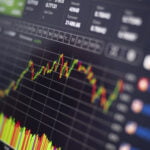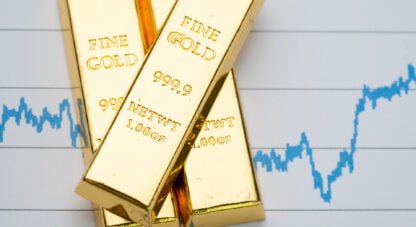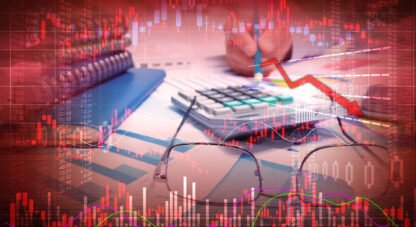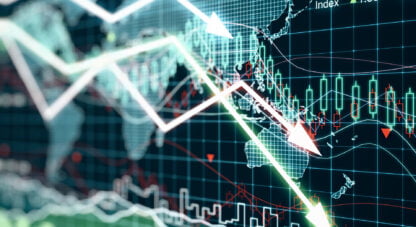Podcast: Play in new window
- While Speculators Gamble On Bed, Bath, & Beyond…
- Gold Buying At 4,741 Tons In 2022
- IMF Sees Sanctions Driving More Gold Buying
Why Are Central Banks Buying So Much Gold
February 8, 2023
“In recent weeks, you’ve had production through the refineries being run at 85% of capacity versus 95%, but it’s a little bit early to be running at 85% capacity. So you’ve had gasoline prices, they’ve come up 40 cents in the last month. Of course, they’re not at last year’s $5 levels. But to see prices migrate higher this far in advance of driving season may present Jerome Powell with the unfortunate truth of inflation refusing to die.” — David McAlvany
Kevin: Welcome to the McAlvany Weekly Commentary, and I’m Kevin Orrick, along with David McAlvany.
Well, the theme this week, Dave, has sort of been balloons, and I know Robert, when he listens to the show, he always asks me here in the office not to sing, but I can’t help myself, 99 Red Balloons. Now, notice I stress red balloons. You remember that song? 99 Red Balloons.
David: What a bother. Who would’ve imagined a deeper meaning there?
Kevin: Yeah, they really are red balloons.
David: Yeah.
Kevin: Yeah, there’s a lot going on there, but we were talking about making the transition, Dave, realizing when a war starts or realizing when a bear market actually is happening. And making the transition is so hard. We as humans have a hard time with the transition. Let’s say there’s an emergency, somebody’s coming at you with a knife, this friend of ours told us, “In martial arts, they train you, you need to tell yourself, ‘I’m being attacked.’” It’s sometimes hard to make that transition.
David: Yeah, as we mentioned last week, the two parts short covering—and this is going back to the recipe for our Long Island Iced Tea, that reference—it moved midweek to three parts short covering after Powell’s comments on disinflation. You clearly see a market that believes this is not a market top. In fact, this is an opportunity to buy, and it’s time to get long.
Powell mentions in his speech the word disinflation 15 times. He talks about tightened financial conditions. And I was amused by the number of professional money managers that pondered quizzically at what Powell meant by tightening financial conditions. Only this week do we see the bank survey from the Fed, where your senior loan officers are invited to say what’s going on. And sure enough, we do see some tightening of financial conditions, particularly in bank lending. But this quizzical look, what does he mean by tightening financial conditions? Because if you look at other common reference points from the October to present period, conditions have in fact loosened.
Mohamed El-Erian was pounding this drum through the weekend. 450 basis points of rate increases have completely been negated in terms of their tightening effect—the Bloomberg Financial Conditions Index just being one of them. Back to pre-rate hike levels—this is March 2022 levels—on that index, and you can appreciate the need to define terms. And I think that’s part of what happened this week, is Powell sat down with the Carlyle chief at the Washington DC Economics Club speech.
Kevin: Yeah. How do you tame inflation when people have not made the transition to either recession or the transition to possibly a bear market in stocks? It certainly doesn’t look like a bear market. The market’s lost all memory of the pain from last year.
David: Well, some of the factors, the [unclear] factors in new inflation, are incredibly volatile. So we’ve had a receding of commodity prices, which is very convenient, but that’s somehow defining the scorecard in terms of the successes of inflation. What a wild ride. I mean, market memory is indeed short. It’s not just the short covering last week.
Kevin: No, there’s speculation in this market, big time.
David: Yeah. We had a very high percentage of dollar volumes attributable to retail traders, and then options volumes hit a new record, and that’s for the month of January. But frankly, you can’t expect investors to have learned much from a bear market that extended to a mere 19% loss. Thinking of the S&P 500 because that’s the most common index for people to invest in. After 12 years of an uptrend, and after nearly 600% of cumulative gains, there’s a lot of conditioning that’s taken place in that space of 12 years to buy the dip. So speculators need only a little rope to hang themselves, and I think Powell provided a lot of rope last week.
Kevin: There are times to be defensive. Like I was mentioning before, if you’re being attacked, you need to say, “I’m being attacked.” Most people, their guard is down at this point. I was reading a book last night, Dave, on celestial navigation in aviation back before World War II and actually leading into World War II. And I had always heard about Pearl Harbor, December 7th, but most people don’t talk about what occurred nine hours later on December 8th in the Philippines at Clark Field. They had flown 35 B-17, beautiful new B-17 bombers—it was the state-of-the-art at the time—to Clark Field. They were out on the field and nine hours after getting news that Pearl Harbor had been bombed, they didn’t do anything. Hap Arnold, the general, later just was chewing out the general in charge, and said, “How in the world…” Actually, he said, “How the hell can you be surprised nine hours after the large attack at Pearl Harbor?” But part of that, Dave, I think has to do with not being defensive when you need to be defensive. I look at you guys as money management right now. You’re not going in and buying Bed, Bath & Beyond. Why?
David: Well, part of it is scenario analysis. I mean, one of the things that we do routinely is look at the possibility of scenario A, B, or C happening, and we come up with what our response is. We don’t know the future, but as things unfold, we don’t want to be caught flatfooted, unable to act because we’re processing new information and our processors are bogged down or overwhelmed. So you avoid being overwhelmed by playing as many scenarios through as possible and figuring out what your game plan is in light of scenario A, B, and C.
Kevin: Well, and you guys have been defensive here this last few weeks while the markets have been exploding.
David: Yeah, I mean many investors don’t recall, maybe they never knew, that when a top is being put in, a significant market top, you can have these vicious countertrend moves. That’s a normal occurrence. They’re not in fact signs of a new bull market, which is one of the reasons why our team—among other things we manage the short fund, Doug manages Tactical Short—play this very defensively. You play it defensively on the short side until the trend is overwhelmingly down. Last year’s positive returns can quickly disappear if risk is not actively managed.
Kevin: Well, and look at the short funds that are out there right now that just stayed fully short on the market. They were betting against the market, and the market beat them.
David: They’re not only a hundred percent short, but they’re short very volatile names. So our competitors on the short side have lost all, and in some cases multiples, of last year’s returns by failing to manage upside beta. Goldman Sachs’ most shorted stocks moved up 5% as Powell finished his comments last Wednesday. They added another 8% on Thursday, for year-to-date increases of over 30%. That’s the Goldman Sachs Most Short Index. AMC—this is, again, really quality, right? AMC popped higher by 14% on Monday. Bed Bath & Beyond, 141% on Monday prior to announcing a round of a fresh capital raising, which took them lower thereafter. Rabid speculation was invited by Powell’s less than hawkish tone, which suggests he’ll manage the narrative this week. But who knows? You look at the market, you look at the speculative community. Once the horse has the bit in its teeth, it’s hard to slow it down. Runaway markets—very difficult to reign in energy that’s in motion.
Kevin: And don’t we normally see the reaction to the other direction of the long-term trend is more radical? So if you’re in a bull market, you’ll have spikes to the downside that are scary. That’s an up market. If you’re in a bear market, you’re going to have these spikes to the upside that actually make you think maybe it might be over.
David: We had, during the tech stock bubble and the bursting of the tech stock bubble, we had 15 rallies. Fifteen rallies.
Kevin: Wow.
David: I mean, most bear markets, not just the tech stock bubble, but most bear markets, when they decline, the rallies that you see in the context of a bear, they range from 15 to 40%. These are significant.
Kevin: That’s huge.
David: They’re sizeable. They’re enough to convince you that you might have missed the bottom and it’s time to start buying. These declines are often interpreted as ideal entry points, but end up being opportunities, unfortunately, for investors to buy all the way down and then with regret sell out at the lows.
Kevin: So is this emotion, psychology, or is it knowing the numbers?
David: I think psychology is more important within the markets than math. And we can pretend that we’ve got equations that help with this or that, but it is ultimately psychology and the way people respond to threat, whether it’s the threat of loss or what have you, that ends up determining the price action of the market. The lack of reason in the equation when investors take a position ends up driving future outcomes, as it’s that same lack of reason that works against them selling out at lower levels.
So yeah, I mean, we kind of make fun of this notion of buy high and sell low. It seems like a bad idea, but it’s the story of most investors. And really it’s no different than the way most people engage with their physical health. You assume and operate as if everything’s okay as long as nothing hurts, and then you pay some attention, you drop everything to resolve the pain when it appears.
We care when we have to. Financial markets force our attention at levels where pain is exaggerated, but typically you see a passivity of mind with your average investor. You hope for the best, but you’re not doing anything else. You’re just hoping for the best. And then when you’re faced with the worst, you’re kind of scrambling. There is no scenario analysis. It’s just, oh, my goodness, what do I do to survive?
Kevin: I just had a heart attack, time to buy a treadmill, right? I mean, isn’t that what is? But last year did have pain in the markets. Are you saying that that pain didn’t fully complete itself, that there’s more?
David: That’s right. Well, 2022 exhibited no signs of panic selling. Last week, we did have panic, but it was panic buying, and it was panic buying in ample volumes. Again, we come back to that three parts short covering. Short covering, yes, that was manic. That was manic. But lots of meme stock speculation. You had your Reddit board braggadocio about positions and gains and easy money, and everybody’s out there just bragging. The greed quotient has not yet gone through a complete bear market cycle, and was easily teased back into play last week. It’s been in play for the last four weeks. Progressive increments since January 1, but with a fabulous crescendo last week, and, of course, into the early days of this week as well.
Kevin: One of the things you watch to see just what the psychology of the market is, is what I would consider the cost of a life jacket. If you were on the Titanic and the cost of life jackets was cheap, it probably would mean you haven’t hit an iceberg yet, right? But maybe you have hit the iceberg, and nobody really cares because the cost of a life jacket in the market, those are called credit default swaps. That’s the insurance on ensuring against losses. What’s the cost of a life jacket right now in the market?
David: Yeah, I mean, and this ties to financial conditions being loose—although Powell will argue that they’re incredibly tight. You look at a variety of metrics, or you can look at a variety of metrics, to figure out what is in play. We define loose financial conditions according to specific metrics. The measurements, for instance, between corporate yields and Treasurys, what’s the gap between them? It tells you where stress is in the corporate credit markets between high yield bonds and Treasurys.
So your lower quality credits, you begin to see stress there as well. The cost to ensure against default, as you mentioned, known as credit default swaps, there’s these and dozens of other measures that we track daily, and they’re at levels seen prior to the Fed’s tightening cycle. February 2022 levels. They had increased dramatically. There was a tightening of financial conditions through August of last year, and they’ve since reversed—reversed hard—moderating in step with the rebound in equities, in step with the rebound in bonds.
So sure, we’ve got real estate lending which has tightened with a doubling of interest rates, both commercial and residential. You’ve got bank lending. I would say even up through the numbers last week you had seen no meaningful tightening, but as of this week we have the Fed survey from senior lenders, and those loan officers are saying, “Yeah, we’re now tightening up.” So there is that indication, which even last week was not public. Perhaps Jerome Powell had access to it, the rest of us did not.
You look at credit in the financial markets, and again I’m thinking about the issuing of bonds, and it has been going at record paces since the beginning of the year. We only had a slight zig and zag last week. Investment grade bonds posted outflows of 582 million, junk bond outflows of 1.497 billion. That’s the first indication of shift, because it’s just been a celebration of largesse, that the amount of credit that’s flowed through Wall Street—let alone the banking system, but through Wall Street—has been stunning, stunning, since the beginning of the year.
Kevin: Well, and then you have the players in the casino, right? You’ve got the public who goes and buys their chips, they play, either winner or lose. I would consider that to be the markets that you’re talking about. And then you have the owners of the casino. They don’t take nearly as much of a risk. I think of the central banks worldwide. I hate to say it, they’re sort of the owners of the casino. You wonder what they’re doing, and you brought up last year that gold buying for the central banks has been record.
David: Yeah, Financial Times one week ago featured commentary on central bank gold demand increasing in 2022, with total demand, looking at all categories, coming in at 4,741 tons. That’s again from all sources. That’s an increase from the previous year by 18%.
A good rule of thumb is mine production. It varies from year to year, but let’s just kind of thumbnail sketch this at say 3,500 tons. If demands goes past that 3,500 tons, you’re going to see a bull market in the metal. And if it’s not to 3,500 tons, then you’ve got a bear market in the metal. You factor in recycling, and there’s a few more hundred tons in play depending on the year.
But you’ve got this IMF paper finished last month, which explored some really interesting dynamics driving central bank demand, and they’re actually not dissimilar from how an individual would look at gold, because again, we come back to psychology, not math. Gold as a central bank reserve was the primary topic, exploring the conditions under which central banks have been buying or selling over the last 20 years, and it was intriguing.
Kevin: Yeah, you told me last night, you said, I’ve got this IMF paper that I need to finish. And Barry Eichengreen, remember he was a guest at one point here on the Commentary, he’s one of the authors. He doesn’t like gold. From a monetary perspective, Barry Eichengreen— It’s not like your dad wrote the paper. This is one of the guys who basically says that gold led us into the last depression.
David: Right. And we all have bias, but his bias is best expressed in his book Golden Fetters, and he is one of the authors of this paper. Not a gold advocate, quite the opposite. He’s besmirched the idea of central bank holdings, and, as you say, attributed a causal connection between the gold standard and the Great Depression.
This is the kind of argument that he develops in his book Golden Fetters. Liquidity constraints were the problem within the depression era—the shackles, the fetters of gold on the monetary system. And of course he misses entirely the role of reckless financial conditions and bank lending throughout the 1920s leading up to excessive valuations and then the implosion in late 1929, ’30, ’31, ’32, that period of time.
Been on the podcast as a guest many years ago. What we were discussing then was the US dollars’ role as a reserve currency. This paper looks at gold as a reserve currency, and uses regression analysis and econometric modeling to try and understand why central banks have been buying so much gold recently.
Kevin: So what were the conclusions? Because I have not read the paper yet.
David: Gold is a safe haven in periods of economic, financial, and geopolitical volatility—that’s one of the big takeaways—and is popular amongst reserve managers when returns on alternative financial assets are low, given the aforementioned causes of uncertainty—again, those categories of economic, financial, or geopolitical volatility. Those kinds of things get people around the table to say, “Hey, maybe we should own some gold.”
We end up talking about it through regression analysis and econometric modeling. There’s a math applied to it. But what is happening is individuals are assessing risk and saying, “I think we need a safe haven.” The second part of the study shows that when sanctions from primary reserve issuing countries, so if you look at the makeup of reserve currencies, the fiat part of the reserves, you’ve got the US, the UK, the EU—so the euro, and the Japanese yen. Those reserve issuing countries, when sanctions increase from them, so does the share of central bank reserves held in the form of gold—reserves held in a form better insulated from sanctions. So we told you all that already, weeks ago, months ago, but without regression analysis and econometric modeling. And this is the key: math is important, but it’s psychology that drives the decisions.
Kevin: It goes back to, “Hey, I’m being attacked.” You either make the decision or not. You can go back and look at all the math and econometrics, and it’s like, “Gosh, I wonder why people are buying gold.” Well, by then, it might be too late. Maybe you should just be buying gold.
Let me ask you a question though, since this was from the IMF, one of the things we do know is that gold is a reserve of these central banks. I don’t know what the percentages that they hold, but that’s got to be something. You talked about sanction-proofing your portfolio if you’re a central bank. If you’re Russia or China or another country that maybe at some point is going to be sanctioned by the United States, it does pay to have more gold. What is the average reserve of these banks in gold versus other currencies?
David: Well, for those who have thought that gold is irrelevant in portfolios, consider that for the global central bank community, gold maintains a 10% allocation of total reserves. That’s an average, and it’s a bit misleading because as an average, that includes the US, Germany, Italy, and France that keep a range of 58 to 66% of all their reserves in gold.
Kevin: Wow. Better than half, US, Germany, who else? Italy.
David: Yeah, Italy and France.
Kevin: Italy and France.
David: And then some countries that have close to zero, so 10 percent’s the average. The big buyers since 1999 are Russia, China, Turkey, and India. Emerging markets began shifting reserves to gold following the global financial crisis. And the paper outlines 14 countries being categorized as active diversifiers.
Kevin: So you and I are active diversifiers as well then?
David: It’s an interesting list. These are countries that are buying a million ounces or more, and started with reserves in gold of say 26% and have moved that to 68%, in the case of, say, Kazakhstan. Turkey has moved up from 4% to 35%. These are significant moves. Uzbekistan 39%, now at 60% between 1999 and the present. Zero percent from Mongolia to 13. Two percent from Mauritius, up to 8%. Serbia from 5 to 12. So there’s a gradual increase, and 2022 was a huge year from the standpoint of central bank buying.
Kevin: So this whole thing about being a historic, outdated relic, I guess not if you’re a central bank.
David: Yeah. Well, and it’s funny because the title of the paper, “Gold as International Reserves,” and then the question, “A Barbarous Relic No More?”
Kevin: Oh, well.
David: Yeah. And I think investors have bought that, hook, line, and sinker—that it’s a commodity, you don’t need it. And it’s been divorced from our minds as the stable part of our reserves—personal reserves, bank reserves, currency reserves.
Kevin: Well, and these central banks are not speculating on price. They’re buying for a different reason.
David: They are buying for a different reason, and that’s the best reason to buy, frankly. That’s the very best reason to buy. And so investors looked at it as, yeah, we’ll pass, better opportunities.
Kevin: Well, Bed, Bath & Beyond, I mean, why wouldn’t you buy a stock of a company that’s going out of business right away?
David: And they want to dilute their shares by a billion dollars right now. You can get in on the action.
Kevin: I don’t see Kazakhstan buying Bed, Bath & Beyond. They’re buying gold.
David: Kazakhstan’s got a whole set of issues that Bed, Bath & Beyond doesn’t have.
Kevin: Yeah, true.
David: Argentina too. From 0% in gold reserves to 8%. And it’s probably the best thing that Argentina’s got going. The paper also explores the dynamic of bank boards responding on a delayed basis to what they call uncertainty events. Gold buying is sort of the lagging decision. It’s an event that happens five to six months later. The buying binge duration varies depending on whether the uncertainty event is economic or geopolitical in nature, and it seems to be longer lasting if it’s economic. Because emergencies happen. We get into a fistfight, and then it’s all resolved very quickly. Typically, geopolitical issues are resolved. Economic issues have deep roots and take a long time to be resolved.
And so on that note of economics: In the research, they look at gold’s negative correlation, or relationship between GDP growth and the acquisition of gold—fiscal balance and the acquisition of gold. Levels of public debt offering further explanatory power for why central banks have taken an interest in gold from 1999 to the present, and why it increased so much here in recent years.
There are of course differences between advanced and emerging markets that they look at as well. But just to clarify, when you have slowing GDP, you have an increased interest in gold, the acquisition of it. When you have a weakening fiscal position in a country, the central bank says, “I think we should have some gold. We’re getting into a tight pickle, we should have a little bit more gold.” If you chart debt, just imagine this expanding hole that you could fall into, gold would be like the leaper leaping over the hole. You could fall into the debt hole or you can bounce and jump right over it. That’s the demand for gold as national debts are on the rise.
Kevin: Well, and one of the things I noticed when you read the countries that are increasing so dramatically, they all have currencies that are not solid, like say the dollar or the euro. I’m wondering if some of these extreme currency moves— You’ve talked about borrowing in dollars and having to pay back in dollars. Probably a gold hedge would help with that, wouldn’t it?
David: Well, differences in currency regimes matter a lot, and floating exchange regimes, those countries that have a floating exchange rate, they typically have more gold. They don’t have to have as much money on hand immediately to take care of short-term currency interventions. So you’re always looking at currency reserves to see if someone has the ability to maintain the value of their currency, but that’s a unique kind of currency regime. In a floating system like ours, you don’t have to defend the currency. In a fixed system like the Chinese, for instance, you want to know what they’ve got in currency reserves because they may spend RNB to defend a range. It doesn’t have to be a particular point, it can be a range. But that currency control requires resources to maintain the band.
Kevin: We talk about being prepared for a change and then making the change. One of the things that I think here in America I have experienced is I’m just used to the dollar being the reserve currency and us basically fighting our war. Most of the war we fight is not kinetic. It’s done with the US Treasury and it’s done with sanctions. You’re talking about some of these countries that are increasing right now. Remember your dad would always say at the end of a talk, he’d say, “He who owns the gold makes the rules.” It seems to me like possibly this increasing reserves in something other than US dollars and something other than maybe some of these floating currencies, in something like gold, we should probably take notice on that.
David: Well, and it may be irksome to our policymakers, whether it’s the Treasury Department or the White House or you name it, if you’re looking overseas to sort of the extension of our power and influence, we may not like the fact that people can insulate themselves from our policy prerogatives. But whether you’re an individual or an individual nation, the role of gold in preserving agency has always been critical. The autonomy and value of choice by the individual, whether you like the person’s or entity’s choices or not, there is something very, very critical to that agency being preserved.
The study on sanctions was compelling. There’s no doubt that gold reserve demand increases directly related to sanctions. So in essence, the West in 2022 drove the rest into the gold market. But you can look back and see specific examples of this. Paraguay encountered significant sanctions from MERCOSUR and UNASUR. This was 2012. They increased their gold reserves by 1141% thereafter. Hungary was sanctioned through the Covid-19 pandemic. This is 2021. They increased their gold reserves by 200%. Belarus by 33%, this is sanctions by the EU and US in 2006. You go through this laundry list of when sanctions were put in place and how those countries gathered around the table and said, “The only way we’re going to maintain our autonomy, the only way we’re going to maintain our agency, is by having our options open, by having a liquid form of capital that is money good anywhere in the world and is actually the best form of reserve.”
Kevin: So we’re not just talking about central banks and governments, we’re talking to people. Let’s face it, nobody can come up to you and say, “Hey, guess what? Because I don’t like you anymore, your gold no longer is valuable.” Whoops. No, that doesn’t happen. Why? Because gold carries the value on its own. So how are you looking toward gold over the next year?
David: I don’t care what you think about Alan Greenspan, but you need to read “Golden Economic Freedom” by Allen Greenspan.
Kevin: What was that, ’67, ’68, something like that?
David: In that timeframe he writes a treatise that is basically, call it a libertarian rant, on why gold is important for maintaining individual freedom and liberty, the autonomy and agency of the individual. There is a philosophical route as to why you save in gold terms and not in some other form. And Greenspan, head of our central bank—he wasn’t at the time, but this was something that made sense to him. Why? Because freedom was important to him.
Kevin: So for the person who has a short-term view and they’ll see gold drop 50 or a hundred bucks, that’s not necessarily what you’re saying for the long run?
David: We’re very bullish on gold, and see year-end numbers taking out the old highs. A correction in gold is interesting from the standpoint of, one—and we’ve mentioned this in previous weeks, the Commitment of Trader reports. And then secondly, from a technical perspective. A correction was anticipated with the commercials increasing their short positions even as managed money speculators were piling in on the long side. And that was going to play out with the momentum crowd arriving late and leaving empty-handed yet again. So the Commitment of Traders report has been begging for a correction in gold, and now we’ve got something in the offing, and I hope it’s significant enough to matter.
The technical picture was one in which overbought conditions, while not extreme, were in the danger zone. And we’ve had a solid move in a short period of time—that move higher from 1613 up to 1950—and you can either correct that sideways consolidation or a correction of that move to lower levels. That has been arguably the outcome. We just didn’t know when it would begin. So couple these factors with completing the Chinese New Year, we’re getting out of a seasonal strong period, the seasonal bright spot in the bullion market always happens around that time, Ramadan and the Chinese New Year are two biggies. And then you’ve got the Powell comments from last week, they boost the dollar and you get recent price action, which is well understood.
Kevin: This is why you can’t live in the dollar aquarium and just look at it from dollar perspective. Because last year gold had a rip-roaring year against virtually all the other currencies except for the dollar because the dollar was strong. Now, the dollars weakened a little bit, and is there a bounce in the dollar that’s in the offing?
David: We talked about the countertrend move in stocks, and if the longer trend is down, then the countertrend would be up, correct? Well, this is countertrend as in we are in a bull market in gold, the countertrend is lower and it corresponds with a decline and now rally in the US dollar. Again, the US dollar has been itching to move higher. It’s declined from its peaks by more than 12%. So to see a rally in the US dollar, no surprise here. A rally in the US dollar putting pressure on gold, that’s what’s developing. And then, of course, we had the decline in the yen, which adds energy to that temporary dollar strength. And this is because the Bank of Japan has clarified that they’ll maintain their yield curve control well past April when the head of the Bank of Japan will change, but the policies apparently will not.
Kevin: So we’ve got over a billion people coming back into an economy that were shut out because of Covid. I mean, what will be the effect of this reopening of China?
David: Well, it’s difficult to say precisely because we really don’t know how quickly this happens. I mean a return to the markets. We have China which reopened January 8th after nearly 1100 days of closure. Covid is still raging as a factor, preventing a return to normalcy. But the expectation is that within weeks or months, this too shall pass, and the Chinese consumer freshly incentivized with cheap credit from the People’s Bank of China will reestablish their footprint in China, the Chinese economy, and thus, the global economy as well.
And you can see travel bookings increasing 200, 250% towards the end of December and into January, as the Chinese are very anxious to get out and see the world. And it follows from this that commodity price pressures, energy price pressures, consumer goods prices will reflect a catch up in purchases from the period of subdued demand. Note that Powell, when he was taking his victory lap last week, was very clear to say, we’ve begun to win this fight, and you can see it with consumer goods. These prices are coming down. Services still moving higher, we need to get control of that, but we will. But his confidence was on the consumer good prices which are coming down.
When you have one of the largest economies and countries by population, certainly, the largest in the world, coming back into the global economy for the first time in three years, you can expect to see commodity price pressure, energy price pressure, consumer price pressure. Why would we not have some version of the excess demand issues faced in the US and Europe post-Covid within China? One of the big differences will be fiscal stimulus measures, which we had $5 trillion worth of here in the US, and that certainly exaggerated demand. We don’t know what the People’s Bank of China will do to incentivize consumption. But even if those fiscal measures remain modest, the return of a population greater than the EU and US combined to the world stage is not insignificant.
Kevin: And so what are we talking? I mean we’re talking probably the things you build things with—the metals, the—
David: That’s right. So that goes back to consumer goods prices. Industrial metals are acting as a lead indicator on Chinese consumption and global price inflation resurgence. You’ve got tin, you’ve got zinc, you get copper up 20% in the last three months according to Financial Times. Tin is up 80% actually since June, and copper has been of interest to speculators in anticipation of the Chinese opening since October, and with hopes that they’ll see some resurgence in terms of property development and real estate sales. Chinese household consumption is being discussed by Chinese leadership as an elevated priority, granted, not for the first time, but perhaps with meaningful sacrifices willing to be made in order to succeed this time.
Kevin: So does that mean we’re going to start seeing flight capital coming back out of China because they know that it’s probably going to be taken? You talk about meaningful sacrifices, what that really is, is, what’s that called, redistribution of wealth, right?
David: Yeah. Redistribution is the name of the game, and flight capital from China already suggests that the wealthy know that both personal and corporate coffers are at risk and will be the resources needed to stabilize the Chinese economy on the base of a billion plus consumers.
Kevin: So, what about energy? We talked about the metals, but what about energy if you’ve got that large population all of a sudden starting to move around again?
David: Oil remains tight on the supply side globally, a very good setup if you’re looking at from here through the end of the year, and that wild card remains how powerfully and how quickly the Chinese economy bounces back. We saw the enthusiastic move—these are price moves higher—in anticipation of the opening. So go back to October, November, we go from, what was it, 73 Brent to 88. Now, we’ll see what the reality of it is, this reopening. How and where will the Chinese consumers show up? So far, not in real estate. Real estate transaction volumes and pricings, that’s not encouraging. The idea of empowering consumption, this is, I think, where you’re seeing policy prerogatives shaped and where you’ll see credit flow. We know from our conversations with past Commentary guests that credit is an instrument of the state, and you let it flow where you want it to go for desired impact. Empowering consumption, again, it’s an old idea, one which the Chinese have talked about repeatedly, but have had difficulty in elevating.
Kevin: Well, so, sticking to the energy question, we were paying $5 at the pump at times last year, are we going to see that again?
David: Well, the concern here in the US is not so much in the crude oil markets. Domestic production has kept up well. I mean, we’ve got supplies still running 12.2 million barrels a day. But you do have refinery bottlenecks, and that’s pressuring gasoline prices higher and it’s keeping diesel at those elevated levels. In recent weeks, you’ve had production through the refineries being run at 85% of capacity versus 95%. And sometimes you’ll see cleaning up, retooling, servicing before the driving months and summer. But it’s a little bit early to be running at 85% capacity. So you’ve had gasoline prices, they’ve come up 40 cents in the last month. Of course, they’re not at last year’s $5 levels. But to see prices migrate higher this far in advance of driving season may present Jerome Powell with the unfortunate truth of inflation refusing to die. I know there’s other factors that will extend the inflation problem, but fuel costs are an easy and obvious concern for consumers.
Kevin: Obviously, employment is not. It seems to me like we actually have more people working right now than probably exist in the United States. Oh, never mind, I’m sure Biden is very happy about that.
David: Well, we have the State of the Union this week, and just in time for the State of the Union, the Bureau of Labor Statistics provides a blowout number. Last Friday, the jobs number, I think you could categorize it as a miracle.
Kevin: Well, it’s mathematically impossible, but it is miraculous.
David: So we have the ADP numbers and the employment indicators—this is where, again, comparing the BLS number with other employment indicators—
Kevin: Did you say BLS?
David: There was an L in there, yes.
Kevin: Okay. Yeah. Okay.
David: There was an L in there. ADP, 106, versus the BLS, five and change. Something’s wrong. Challenger, Gray & Christmas, again, supporting evidence that perhaps one of these does not look like the other, and for good reason. You statistically goose the number not only with seasonal adjustments, but you recalculate the entire US population, and again, you goose the employment number by 517. That opportunity won’t be lost in the State of the Union. I think whether it’s last Wednesday’s Powell commentary on the economy, inflation, and rates, or this week’s State of the Union crowing is some of what I see. The victory lap, the crowing. And sometimes you see crowing and eating crow follow each other sequentially.
Kevin: You’ve been listening to the McAlvany Weekly commentary. I’m Kevin Orrick, along with David McAlvany. You can find us at mcalvany.com, M-C-A-L-V-A-N-Y.com, and you can call us at (800) 525-9556.
This has been the McAlvany Weekly commentary. The views expressed should not be considered to be a solicitation or a recommendation for your investment portfolio. You should consult a professional financial advisor to assess your suitability for risk and investment. Join us again next week for a new edition of the McAlvany Weekly Commentary.
















